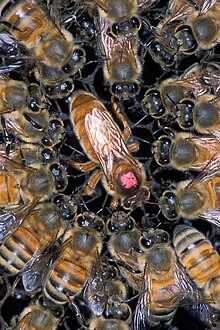
Back Gynomorphe German Gina Spanish ماده (حشرات) Persian Hyönteiskuningatar Finnish Monogyne French Gine Malay 羣乸 ZH-YUE

The gyne (/ˈɡaɪn/, from Greek γυνή, "woman") is the primary reproductive female caste of social insects (especially ants, wasps, and bees of order Hymenoptera, as well as termites). Gynes are those destined to become queens, whereas female workers are typically barren and cannot become queens. Having a queen is what makes a "queenright" hive, nest, or colony of eusocial insects.[1][2] A colony with multiple queens is said to be a polygyne form, whereas one with only one is a monogyne form.
The ancient Greek origin of gyne meant a woman who had given birth to at least one child.[3]
In species lacking morphological castes (i.e., where "workers" may not be sterile), the term "gyne" is usually reserved for those females whose entire life is spent as a reproductive or potential reproductive, as opposed to those who start life as a worker and subsequently attain reproductive status (often called a "replacement queen" or a "laying worker"). These can be seen in certain species of stingless bee like the Plebeia remota where both gynes and workers are capable of reproducing.[4] In most species with annual colony cycles, only gynes can enter diapause and overwinter, while workers – both non-reproductive and reproductive – die off. In some groups, such as paper wasps, gynes join with other gynes at the time of nest founding, and may be relegated to subordinate reproductive roles, so being a gyne does not guarantee that a female will become a queen.
- ^ Cite error: The named reference
queenright-Merriam-Websterwas invoked but never defined (see the help page). - ^ Cite error: The named reference
Helantera-Ratnieks-2019was invoked but never defined (see the help page). - ^ Women in Classical Greece https://www.metmuseum.org/toah/hd/wmna/hd_wmna.htm
- ^ Benthem, F. D. J. van; Imperatriz-Fonseca, V. L.; Velthuis, H. H. W. (1995-03-01). "Biology of the stingless beePlebeia remota (Holmberg): observations and evolutionary implications". Insectes Sociaux. 42 (1): 71–87. doi:10.1007/BF01245700. ISSN 0020-1812. S2CID 45830578.
© MMXXIII Rich X Search. We shall prevail. All rights reserved. Rich X Search